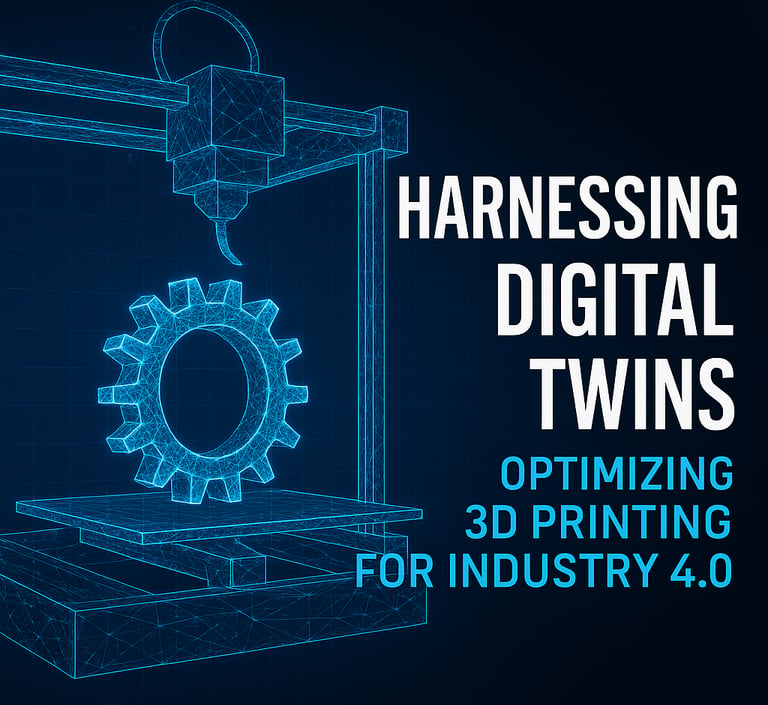Harnessing Digital Twins: Optimizing 3D Printing for Industry 4.0
Discover how integrating digital twins with additive manufacturing accelerates design validation, improves part quality, and drives sustainable, cost-effective production.
3D PRINTING
Pacific Labs
5/15/20252 min read


1. Virtual Design Validation
Digital twins start with a precise 3D model—often from CAD or 3D scans—that serves as the “master” for simulation and analysis. Advanced software platforms (e.g., Siemens’ Digital Enterprise Suite, Autodesk Netfabb) allow engineers to run virtual trials on this twin, testing factors like thermal stresses, mechanical loads, and material behavior under operating conditions. This upfront virtual validation slashes physical iteration cycles by up to 60%, accelerating time-to-market and reducing wasted material ﹘ a critical advantage as 3D printing moves from prototyping to production.
2. Real-Time Build Monitoring
By streaming live process data (temperature, layer accuracy, recoater forces) into the digital twin, operators gain full visibility into each build’s status. Platforms like AMFG and 3D Printer OS integrate IoT sensors to detect anomalies—such as powder bed irregularities or power spikes—and trigger automated interventions, preventing failed prints and costly re-work . Continuous feedback ensures every layer conforms to specifications, a necessity for high-stakes parts in aerospace and medical applications.
3. Predictive Maintenance & Equipment Twins
Equipment digital twins mirror the health of 3D printers themselves. By analyzing vibration, motor currents, and component wear data, machine-learning models forecast service intervals and potential failures well before breakdowns occur. This shift from reactive to predictive maintenance boosts machine uptime, lowers operating expenses, and extends printer lifespan—a crucial KPI as production lines scale and leverage large-format metal and polymer printers.
4. Facility-Level Optimization
Facility twins aggregate data from multiple printers, post-processing stations, and material workflows to optimize floor layouts, production scheduling, and resource allocation. Digital threads—seamless data flows linking design, simulation, production, and quality records—enable end-to-end traceability for regulatory compliance and customer transparency. In smart factories, this holistic view drives continuous improvement, reduces lead times, and supports dynamic scaling in response to demand.
Conclusion & Call to Action
As digital twin technologies mature, their synergy with additive manufacturing unlocks unparalleled efficiencies, quality gains, and sustainability. At Pacific Labs, we leverage virtual and physical twins to deliver robust prototyping and production services—from initial concept through real-time monitoring and maintenance forecasting. Ready to future-proof your manufacturing?
Visit www.pacificlabs.co.in or contact us at info@pacificlabs.co.in to explore tailored digital-twin solutions for your next project.
Digital twins—virtual replicas of physical assets or processes—are transforming additive manufacturing by enabling real-time simulation, predictive analytics, and continuous optimization. By linking sensor data from 3D printers with rich simulation models, manufacturers can validate designs before printing, monitor builds in flight, and forecast maintenance needs, reducing trial-and-error costs and elevating part reliability. The digital twin market is projected to reach $29 billion in 2025, driven by industrial IoT, AI, and expanding use cases in aerospace, automotive, and healthcare.
Below, we delve into the four principal ways digital twins enhance 3D printing workflows.
Stay connected with Pacific Labs
Pacific Labs
256, Adarsh colony, Balongi,
S.A.S Nagar (Mohali), Punjab. 160055
Contact US:
Get in touch
info@pacificlabs.co.in
pacificlabs3d@gmail.com
+91 9872791819
© 2025 Pacific Labs. All rights reserved.
Follow us
+91 7740001952
